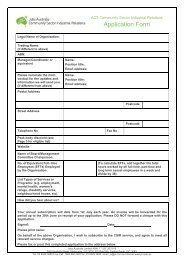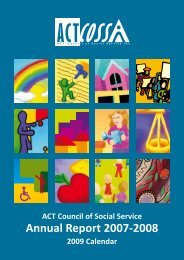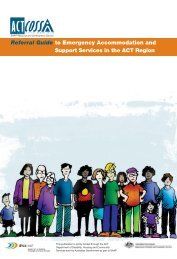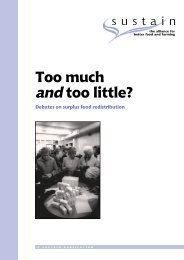actcoss text final.indd - ACT Council of Social Service
actcoss text final.indd - ACT Council of Social Service
actcoss text final.indd - ACT Council of Social Service
You also want an ePaper? Increase the reach of your titles
YUMPU automatically turns print PDFs into web optimized ePapers that Google loves.
Failures <strong>of</strong> service coordination and cooperation<br />
undermine continuity <strong>of</strong> care and result in service<br />
gaps. A number <strong>of</strong> the service gaps identified by<br />
participants reflect such failures, including:<br />
• case management;<br />
• coordinated dual-diagnosis services;<br />
• discharge planning;<br />
• follow-up;<br />
• PPEI for Indigenous communities; and<br />
• Dual-disability services.<br />
The <strong>ACT</strong> Mental Health Strategy and Action Plan<br />
identified the need to develop a collaborative<br />
approach to service delivery for clients with complex<br />
needs. It should be noted that the Complex Needs<br />
Working Group was established in 2005 by the<br />
Implementation Group to research effective ways<br />
to improve service integration and collaboration. It<br />
involves members from government and community<br />
services, in addition to consumers, carers and<br />
community representatives. The Working Group<br />
distributed a discussion paper, held a number <strong>of</strong><br />
consultations with stakeholders in March-April 2005<br />
and has published a <strong>final</strong> report on consultations.<br />
Further reform proposals are anticipated. These<br />
should be taken into account as mental health<br />
service reforms are progressed.<br />
Formal inter-agency agreements<br />
and projects<br />
Very few community sector organisations indicated<br />
that they had MOUs, or some other kind <strong>of</strong><br />
formal agreement, with other community sector<br />
organisations. Similarly, few consulted organisations<br />
had been involved in joint projects with other<br />
organisations, with many participants expressing<br />
scepticism about joint projects, perceiving them to<br />
be ‘too difficult’ or ‘too time consuming’. Several<br />
organisations, however, expressed enthusiasm about<br />
the prospect <strong>of</strong> being involved in such projects in the<br />
future.<br />
Case management<br />
There was a low level <strong>of</strong> community case<br />
management generally reported, with some notable<br />
exceptions. However, some instances <strong>of</strong> service<br />
coordination around particular service-users were<br />
reported to occur. For example, AOD services<br />
reported that workers would sometimes initiate<br />
and maintain contact with a dual-diagnosis client in<br />
a mental health facility, while some mental health<br />
and supported accommodation workers indicated<br />
that they would maintain contact with clients while<br />
in detoxification. These instances <strong>of</strong> coordination<br />
seemed to take place in relation to particular<br />
individuals rather than as the implementation <strong>of</strong> a<br />
service coordination strategy. In another example,<br />
consumer consultation participants highlighted<br />
the role that the <strong>ACT</strong> Disability, Aged and Carer<br />
Advocacy <strong>Service</strong> (ADACAS) plays in coordinating<br />
services for clients (everything from utilities to mental<br />
health services), but noted that the service was <strong>of</strong>ten<br />
functioning at maximum capacity, and unable to<br />
assist all those in need. Ultimately, case management<br />
was consistently identified as a capacity that the<br />
community sector wishes to further develop. This<br />
is consistent with the Australian <strong>Council</strong> <strong>of</strong> <strong>Social</strong><br />
<strong>Service</strong> (ACOSS) Community Sector Survey<br />
finding<br />
that case management was identified as a priority<br />
training need. 77<br />
Referral and information pathways<br />
All consultation participants indicated that they had<br />
referral and information relationships with other<br />
community organisations, either within the same<br />
sub-sector (for example, mental health) and/or<br />
between organisations in different sub-sectors (for<br />
example, primary health and mental health). Some<br />
engaged in resource-sharing, co-location and joint<br />
projects, though these activities were less common.<br />
In many cases, relationships seemed dependant<br />
on contacts between particular managers or staff<br />
members, and represented an ad hoc rather than<br />
coordinated or systemic relationship. The women’s<br />
sector was an exception, with an agreed pathway<br />
between services and some commitment to a ‘no<br />
___________________________________________________________________________________________________________________________<br />
77 Australian <strong>Council</strong> <strong>of</strong> <strong>Social</strong> <strong>Service</strong>, Australian Community Sector Survey Report 2007, ACOSS Paper 145, February 2007 at 92.<br />
25 Towards an integrated mental health service system in the <strong>ACT</strong>•June 2007 NO WRONG DOORS













